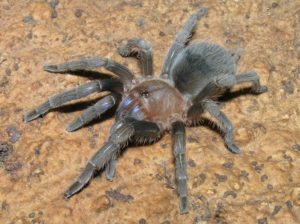The Costa Rican bluefront tarantula is a fascinating spider with bright blue mouthparts, giving it its unique name. Native to the vibrant landscapes of Costa Rica, this spider is part of the large tarantula family. Explore this post to discover intriguing facts about this colorful creature.

Aphonopelma burica
Females lay their eggs inside a sac made of webbing.
Spiderlings are brown with a black abdomen.
As ambush predators, they do not use webbing to capture prey.
Yes, Costa Rican Bluefront Tarantulas are venomous, like most tarantulas. However, their venom is generally not harmful to humans.
Yes, they can bite if they feel threatened. While the bite might be painful, it’s typically not dangerous for humans.
The Costa Rican bluefront tarantula plays an important ecological role as a predator, controlling the population of insects and contributing to the food chain in its tropical forest habitat.
Natural Predators: Despite their venomous defense, they are not apex predators and are prey to larger animals such as birds, mammals, and reptiles, which help regulate their population numbers.
Prey-Predator Dynamics: Their predatory nature ensures the balance of insect populations, preventing overpopulation and the potential harm it could cause to the environment.
Relationship with Humans: Human encounters with the Costa Rican bluefront tarantula are uncommon due to the spider’s reclusive nature. When interactions occur, it’s important to maintain a respectful distance to avoid any defensive bites.
| Lifespan | Males: 5 years, Females: 15-20 years |
| Distribution | Costa Rica |
| Habitat | Tropical forests |
| Diet | Cockroaches, crickets, mealworms |
In summary, the Costa Rican bluefront tarantula is a remarkable species that not only captivates with its vivid coloration but also plays a vital role in maintaining the ecological balance within its native habitat.
Image Source: memberfiles.freewebs.com, inaturalist.com
The Costa Rican bluefront tarantula is a fascinating spider with bright blue mouthparts, giving it its unique name. Native to the vibrant landscapes of Costa Rica, this spider is part of the large tarantula family. Explore this post to discover intriguing facts about this colorful creature.

Aphonopelma burica
Females lay their eggs inside a sac made of webbing.
Spiderlings are brown with a black abdomen.
As ambush predators, they do not use webbing to capture prey.
Yes, Costa Rican Bluefront Tarantulas are venomous, like most tarantulas. However, their venom is generally not harmful to humans.
Yes, they can bite if they feel threatened. While the bite might be painful, it’s typically not dangerous for humans.
The Costa Rican bluefront tarantula plays an important ecological role as a predator, controlling the population of insects and contributing to the food chain in its tropical forest habitat.
Natural Predators: Despite their venomous defense, they are not apex predators and are prey to larger animals such as birds, mammals, and reptiles, which help regulate their population numbers.
Prey-Predator Dynamics: Their predatory nature ensures the balance of insect populations, preventing overpopulation and the potential harm it could cause to the environment.
Relationship with Humans: Human encounters with the Costa Rican bluefront tarantula are uncommon due to the spider’s reclusive nature. When interactions occur, it’s important to maintain a respectful distance to avoid any defensive bites.
| Lifespan | Males: 5 years, Females: 15-20 years |
| Distribution | Costa Rica |
| Habitat | Tropical forests |
| Diet | Cockroaches, crickets, mealworms |
In summary, the Costa Rican bluefront tarantula is a remarkable species that not only captivates with its vivid coloration but also plays a vital role in maintaining the ecological balance within its native habitat.
Image Source: memberfiles.freewebs.com, inaturalist.com